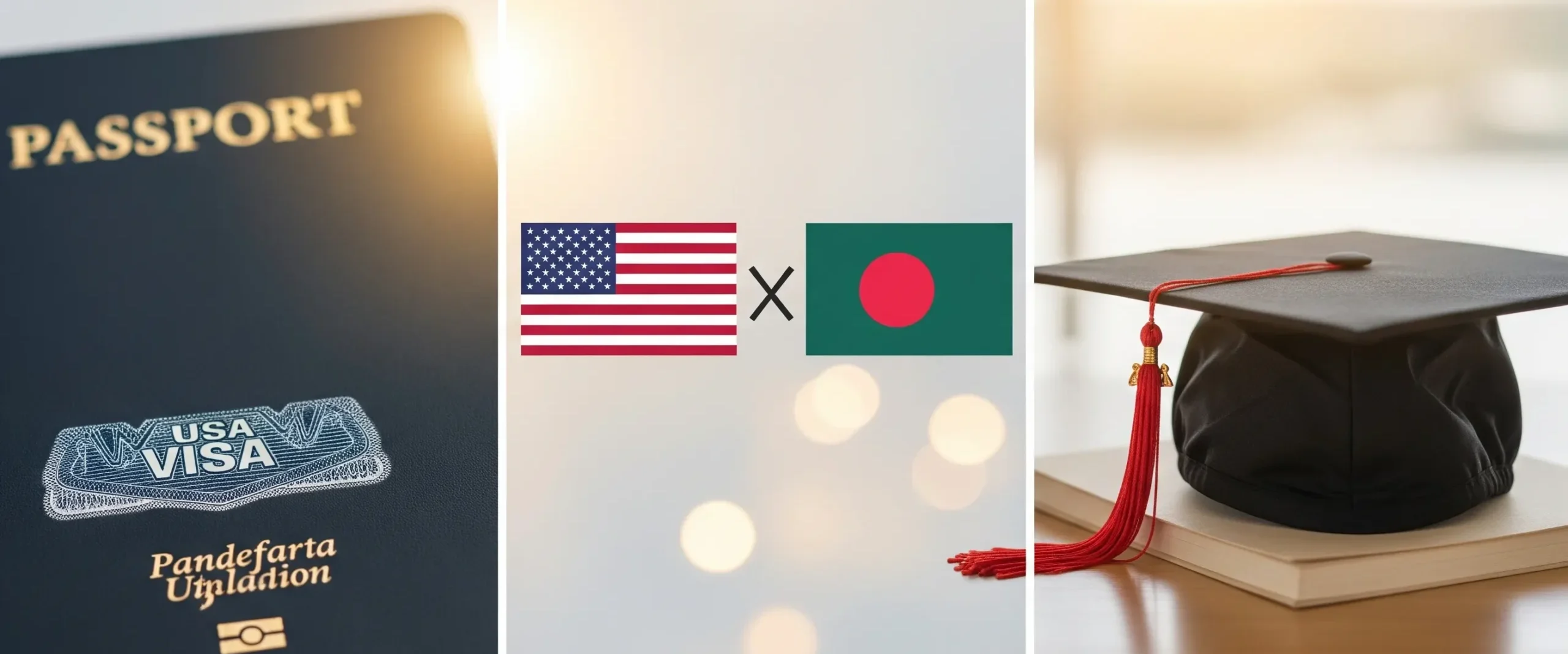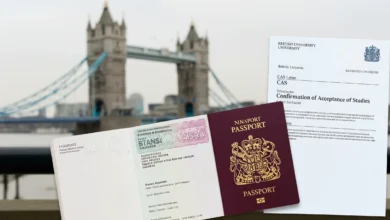How to get us student visa from bangladesh

So, you’ve done the hard work. You’ve aced your standardized tests, written compelling essays, and secured an acceptance letter from a university in the United States. Congratulations! That’s a massive achievement. But there’s one final, crucial hurdle between your dream and reality: the student visa.
For many Bangladeshi students, the visa process can seem like a daunting black box of forms, fees, and a nerve-wracking interview. But it doesn’t have to be.
This comprehensive guide will walk you through exactly how to get a US student visa (F-1 visa) from Bangladesh. We’ll break down every step, from the initial paperwork to acing your interview at the U.S. Embassy in Dhaka. Think of this as your roadmap to success.
The Foundation: Before You Apply for the Visa
You cannot apply for a student visa until you have two very important things sorted out. Don’t even think about the DS-160 form until you’ve completed this phase.
1. Secure Admission from an SEVP-Certified School
First and foremost, you must be accepted by a school that is certified by the Student and Exchange Visitor Program (SEVP). This is a non-negotiable requirement. SEVP certification means the U.S. government recognizes the institution as a legitimate place for international students to study. You can verify a school’s certification on the official SEVP school search page.
2. Receive Your Form I-20
Once you have accepted an offer of admission and paid any required deposits, the school’s Designated School Official (DSO) will issue you a Form I-20, “Certificate of Eligibility for Nonimmigrant Student Status.”
This document is your golden ticket. It’s the single most important piece of paper in the initial stages of your visa journey. It contains your unique SEVIS ID number, program details, and estimated costs. Review it carefully to ensure all your personal information is correct.
The Core Process: Your Step-by-Step Visa Application
With your I-20 in hand, it’s time to begin the formal visa application process. Follow these steps in order.
Step 1: Pay the SEVIS I-901 Fee
Before you can schedule your visa interview, you must pay the SEVIS I-901 fee. This fee funds the Student and Exchange Visitor Program that tracks your status while you are in the U.S.
- How: Visit the official FMJfee.com website.
- What you’ll need: Your SEVIS ID (from your I-20), name, and date of birth exactly as they appear on the I-20.
- Pro Tip: Pay this fee as soon as you get your I-20. Keep the payment receipt safe; you will need it for your visa interview.
Step 2: Complete the Online Visa Application (Form DS-160)
The DS-160 is a detailed online form where you provide your personal, educational, and travel history. This is the cornerstone of your application, and the information you provide will be used by the consular officer during your interview.
- Where: Access the form on the U.S. Department of State’s Consular Electronic Application Center.
- Key Tips for Success:
- Be 100% Honest: Any discrepancy, even a small one, can lead to a visa denial.
- Be Thorough: Answer every question completely. If a question doesn’t apply, choose “Does Not Apply.”
- Save, Save, Save: The form can time out. Note down your Application ID and save your progress frequently.
- Upload a Proper Photo: You will need a digital photograph taken within the last six months that meets the strict government requirements.
- Proofread: Before submitting, review every single answer. Once submitted, you cannot make changes. Print the confirmation page with the barcode; you must bring this to your interview.
Step 3: Pay the Visa Application (MRV) Fee
This is the fee for the visa application itself, often called the Machine Readable Visa (MRV) fee. The fee amount is subject to change, so always check the official U.S. Embassy in Bangladesh website for the current fee and payment instructions. In Bangladesh, this is typically paid at select branches of specific banks. You will get a receipt after payment, which is essential for the next step.
Step 4: Schedule Your Appointments
With your DS-160 confirmation and MRV fee receipt, you can now schedule your appointments. In Bangladesh, this is a two-step process:
- OFC Appointment: You will first schedule an appointment at the Offsite Facilitation Center (OFC) to have your fingerprints and photograph taken.
- Visa Interview Appointment: You will then schedule your actual visa interview at the U.S. Embassy in Dhaka.
You can schedule both appointments through the official CGI Federal visa services website for Bangladesh. Try to schedule your OFC appointment a day or two before your embassy interview.
Preparing Your Document Arsenal
Being organized is key. The consular officer may not ask to see every document, but you must have them ready. Use a clear folder with organized sections.
Mandatory Documents:
- Passport (valid for at least six months beyond your intended stay)
- DS-160 Confirmation Page
- Appointment Confirmation Letter
- SEVIS I-901 Fee Payment Receipt
- MRV Fee Payment Receipt
- One copy of your visa photo (in case there’s an issue with the digital one)
- Original Form I-20 (and a copy)
Academic Documents:
- Original transcripts, mark sheets, and certificates (SSC, HSC, Bachelor’s, etc.)
- Standardized test scores (SAT, GRE, GMAT, TOEFL, IELTS)
- University acceptance letter
Financial Documents (Crucial for Bangladeshi Applicants): This is where many applications falter. You must prove, without a doubt, that you or your sponsor can cover the full cost of your first year of study and have a credible plan to fund the rest.
- Bank statements for the last 6-12 months.
- Affidavit of Support (Form I-134) if you have a U.S.-based sponsor.
- Sponsor’s financial documents: job letter, salary statements, income tax returns, business registration documents.
- Proof of liquid assets: fixed deposit receipts (FDRs), savings certificates, etc.
- Proof of property ownership (deeds, valuation certificates) can be supplementary but are less important than liquid funds.
Proof of “Ties to Home Country” (Equally Crucial): The consular officer needs to be convinced that you will return to Bangladesh after completing your studies. This is a primary condition for an F-1 visa.
- Family ties: Documents showing your family lives in Bangladesh (e.g., family photos, parents’ job info).
- Economic ties: Proof of property or business ownership in your family’s name. A post-graduation job offer in Bangladesh is excellent if you can get one.
- Future plans: Be prepared to articulate a clear plan for what you will do in Bangladesh after your degree.
Acing the Final Boss: Your Visa Interview
The interview itself is often just 2-3 minutes long. The officer has likely already reviewed your DS-160 and formed a preliminary impression. Your job is to reinforce that you are a genuine, credible student.
What the Consular Officer is Looking For:
- Are you a legitimate student?
- Can you pay for your education?
- Will you return to Bangladesh after your studies?
Common Interview Questions for Bangladeshi Students:
- Why did you choose this university?
- Why do you want to study in the USA?
- What is your major and why did you choose it?
- Who is sponsoring your education? What do they do?
- What are your plans after graduation?
- Have you ever been to the U.S. before?
- Do you have relatives in the U.S.?
Tips for a Successful Interview:
- Dress Professionally: Smart casual is perfect. Look neat and serious.
- Be Confident and Calm: Greet the officer with a smile. Make eye contact.
- Answer Honestly and Directly: Don’t give long, memorized speeches. Answer the question asked, and then stop.
- Speak for Yourself: Even if your parents are your sponsors, you are the applicant. You should know all the details of your finances and plans.
- Know Your ‘Why’: Be passionate and clear about your academic and career goals.
After the Interview
- Approved: If approved, the officer will keep your passport and tell you it’s been approved. You will be notified when you can collect it from the designated collection center.
- Refused (214(b)): The most common reason for refusal is under section 214(b), which means you failed to convince the officer of your intent to return to Bangladesh. If this happens, listen carefully to the reason, take the refusal slip, and you can reapply later once you have addressed the shortcomings of your previous application.
Getting a US student visa from Bangladesh is a methodical process. It requires organization, honesty, and thorough preparation. Focus on presenting yourself as a serious student with a clear plan and strong ties to your home country.
Your American dream is within reach. Good luck!
Disclaimer:
The information provided in this guide is for general informational purposes and does not constitute legal or official immigration advice. U.S. visa laws, application procedures, and fees (including SEVIS and MRV fees) are complex, set by the U.S. government, and are subject to change at any time.
For the most accurate, official, and up-to-date information, you MUST consult the official websites of the U.S. Department of State and the U.S. Embassy in Bangladesh. Do not rely solely on this or any other third-party guide for your visa application. Your reliance on any information provided here is strictly at your own risk.


